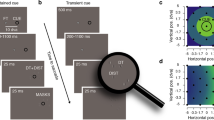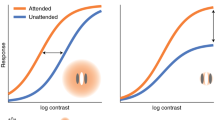Abstract
Many cells in retinotopic brain areas increase their activity when saccades (rapid eye movements) are about to bring stimuli into their receptive fields. Although previous work has attempted to look at the functional correlates of such predictive remapping, no study has explicitly tested for better attentional performance at the future retinal locations of attended targets. We found that, briefly before the eyes start moving, attention drawn to the targets of upcoming saccades also shifted to those retinal locations that the targets would cover once the eyes had moved, facilitating future movements. This suggests that presaccadic visual attention shifts serve to both improve presaccadic perceptual processing at the target locations and speed subsequent eye movements to their new postsaccadic locations. Predictive remapping of attention provides a sparse, efficient mechanism for keeping track of relevant parts of the scene when frequent rapid eye movements provoke retinal smear and temporal masking.
This is a preview of subscription content, access via your institution
Access options
Subscribe to this journal
Receive 12 print issues and online access
$209.00 per year
only $17.42 per issue
Buy this article
- Purchase on Springer Link
- Instant access to full article PDF
Prices may be subject to local taxes which are calculated during checkout





Similar content being viewed by others
References
Castet, E., Jeanjean, S. & Masson, G.S. Motion perception of saccade-induced retinal translation. Proc. Natl. Acad. Sci. USA 99, 15159–15163 (2002).
Mack, A. & Rock, I. Inattentional Blindness (MIT Press, Cambridge, Massachusetts, 1998).
O'Regan, J.K., Rensink, R.A. & Clark, J.J. Change-blindness as a result of 'mudsplashes'. Nature 398, 34 (1999).
Wurtz, R.H. Neuronal mechanisms of visual stability. Vision Res. 48, 2070–2089 (2008).
Deubel, H. The time course of presaccadic attention shifts. Psychol. Res. 72, 630–640 (2008).
Montagnini, A. & Castet, E. Spatiotemporal dynamics of visual attention during saccade preparation: independence and coupling between attention and movement planning. J. Vis. 7, 1–16 (2007).
Deubel, H. & Schneider, W.X. Saccade target selection and object recognition: evidence for a common attentional mechanism. Vis. Res. 14, 1827–1837 (1996).
Kowler, E., Anderson, E., Dosher, B. & Blaser, E. The role of attention in the programming of saccades. Vision Res. 35, 1897–1916 (1995).
Baldauf, D. & Deubel, H. Properties of attentional selection during the preparation of sequential saccades. Exp. Brain Res. 184, 411–425 (2008).
Gersch, T.M., Schnitzer, B.S., Sanghvi, P.S., Dosher, B. & Kowler, E. Attentional enhancement along the path of a sequence of saccades. Vis. Cogn. 14, 104–107 (2006).
Godijn, R. & Theeuwes, J. Parallel allocation of attention prior to the execution of saccade sequences. J. Exp. Psychol. Hum. Percept. Perform. 29, 882–896 (2003).
Awh, E., Armstrong, K.M. & Moore, T. Visual and oculomotor selection: links, causes and implications for spatial attention. Trends Cogn. Sci. 10, 124–130 (2006).
Cavanagh, P., Hunt, A.R., Afraz, A. & Rolfs, M. Visual stability based on remapping of attention pointers. Trends Cogn. Sci. 14, 147–153 (2010).
Duhamel, J.-R., Colby, C.L. & Goldberg, M.E. The updating of the representation of visual space in parietal cortex by intended eye movements. Science 255, 90–92 (1992).
Sommer, M.A. & Wurtz, R.H. Influence of the thalamus on spatial visual processing in frontal cortex. Nature 444, 374–377 (2006).
Gottlieb, J.P., Kusunoki, M. & Goldberg, M.E. The representation of visual salience in monkey parietal cortex. Nature 391, 481–484 (1998).
Berman, R. & Colby, C.L. Attention and active vision. Vision Res. 49, 1233–1248 (2009).
Mathôt, S. & Theeuwes, J. Evidence for the predictive remapping of visual attention. Exp. Brain Res. 200, 117–122 (2010).
Melcher, D. Predictive remapping of visual features precedes saccadic eye movements. Nat. Neurosci. 10, 903–907 (2007).
Becker, W. & Jürgens, R. An analysis of the saccadic system by means of double step stimuli. Vision Res. 19, 967–983 (1979).
Hallett, P.E. & Lightstone, A.D. Saccadic eye movements to flashed targets. Vision Res. 16, 107–114 (1976).
Collins, T., Rolfs, M., Deubel, H. & Cavanagh, P. Post-saccadic location judgments reveal remapping of saccade targets to non-foveal locations. J. Vis. 9, 1–9 (2009).
Karni, A. & Sagi, D. Where practice makes perfect in texture discrimination: evidence for primary visual-cortex plasticity. Proc. Natl. Acad. Sci. USA 88, 4966–4970 (1991).
Polat, U. & Sagi, D. Lateral interactions between spatial channels: suppression and facilitation revealed by lateral masking experiments. Vision Res. 33, 993–999 (1993).
Solomon, J.A. The effect of spatial cues on visual sensitivity. Vision Res. 44, 1209–1216 (2004).
Melcher, D. & Colby, C.L. Trans-saccadic perception. Trends Cogn. Sci. 12, 466–473 (2008).
Knapen, T., Rolfs, M., Wexler, M. & Cavanagh, P. The reference frame of the tilt aftereffect. J. Vis. 10, 1–13 (2010).
Guthrie, B.L., Porter, J.D. & Sparks, D.L. Corollary discharge provides accurate eye position information to the oculomotor system. Science 221, 1193–1195 (1983).
Sommer, M.A. & Wurtz, R.H. A pathway in primate brain for internal monitoring of movements. Science 296, 1480–1482 (2002).
Chen, Y. et al. Task difficulty modulates the activity of specific neuronal populations in primary visual cortex. Nat. Neurosci. 11, 974–982 (2008).
Macknik, S.L. & Martinez-Conde, S. Chapter 81: The role of feedback in visual attention and awareness. in The Cognitive Neurosciences 4th edn. (ed. Gazzaniga, M.S.) 1165–1179 (MIT Press, Cambridge, Massachusetts, 2009).
Golomb, J.D., Chun, M.M. & Mazer, J.A. The native coordinate system of spatial attention is retinotopic. J. Neurosci. 28, 10654–10662 (2008).
Brainard, D.H. The Psychophysics Toolbox. Spat. Vis. 10, 433–436 (1997).
Pelli, D.G. The VideoToolbox software for visual psychophysics: transforming numbers into movies. Spat. Vis. 10, 437–442 (1997).
Cornelissen, F.W., Peters, E.M. & Palmer, J. The Eyelink Toolbox: eye tracking with MATLAB and the Psychophysics Toolbox. Behav. Res. Methods Instrum. Comput. 34, 613–617 (2002).
Watson, A.B. & Pelli, D.G. QUEST: a Bayesian adaptive psychometric method. Percept. Psychophys. 33, 113–120 (1983).
Engbert, R. & Mergenthaler, K. Microsaccades are triggered by low retinal image slip. Proc. Natl. Acad. Sci. USA 103, 7192–7197 (2006).
Rolfs, M., Engbert, R. & Kliegl, R. Crossmodal coupling of oculomotor control and spatial attention in vision and audition. Exp. Brain Res. 166, 427–439 (2005).
Acknowledgements
We thank C. Buß for help with data acquisition. This work was supported by the 7th Framework Program of the European Commission (Marie Curie International Outgoing Fellowship 235625 awarded to M.R.), by Deutsche Forschungsgemeinschaft (GRK 1091, as a fellowship to D.J.) and by a Chaire d'Excellence grant to P.C.
Author information
Authors and Affiliations
Contributions
M.R., D.J., H.D. and P.C. designed the experiments. M.R. and D.J. conducted the experiments and analyzed the data. M.R. and P.C. wrote the manuscript. P.C. and H.D. supervised the project. All of the authors discussed the results and commented on the manuscript.
Corresponding authors
Ethics declarations
Competing interests
The authors declare no competing financial interests.
Supplementary information
Supplementary Text and Figures
Supplementary Figures 1–5 (PDF 1364 kb)
Rights and permissions
About this article
Cite this article
Rolfs, M., Jonikaitis, D., Deubel, H. et al. Predictive remapping of attention across eye movements. Nat Neurosci 14, 252–256 (2011). https://doi.org/10.1038/nn.2711
Received:
Accepted:
Published:
Issue Date:
DOI: https://doi.org/10.1038/nn.2711
This article is cited by
-
Inferring visual space from ultra-fine extra-retinal knowledge of gaze position
Nature Communications (2023)
-
Coupling perception to action through incidental sensory consequences of motor behaviour
Nature Reviews Psychology (2022)
-
Return-sweep saccades in oral reading
Psychological Research (2022)
-
Perception of the Nose and Lower Face Before and After Orthognathic Surgery in Subjects with Dento-maxillofacial Deformities: An Eye-Tracking Study
Aesthetic Plastic Surgery (2022)
-
Gaze interaction: anticipation-based control of the gaze of others
Psychological Research (2021)



